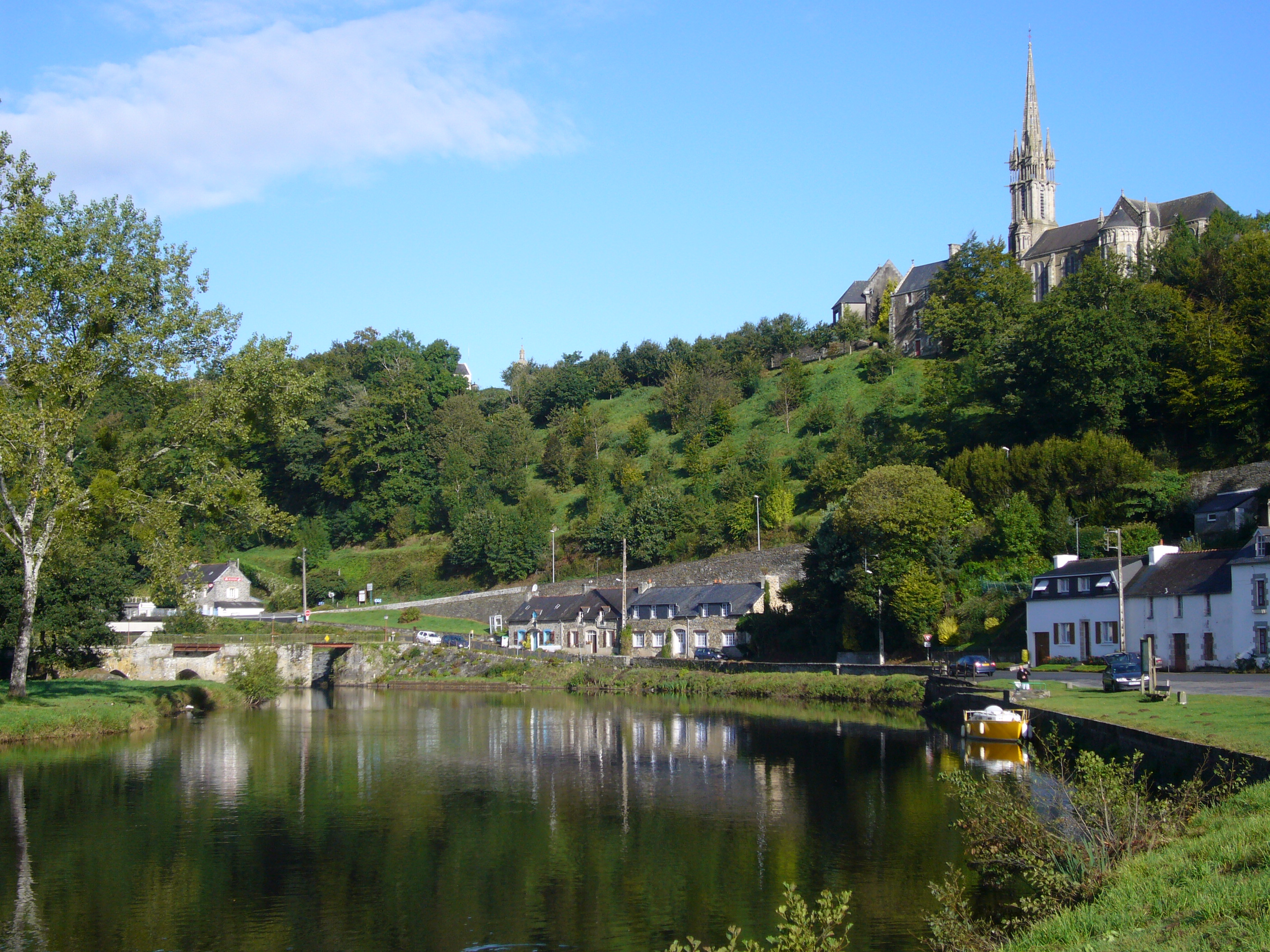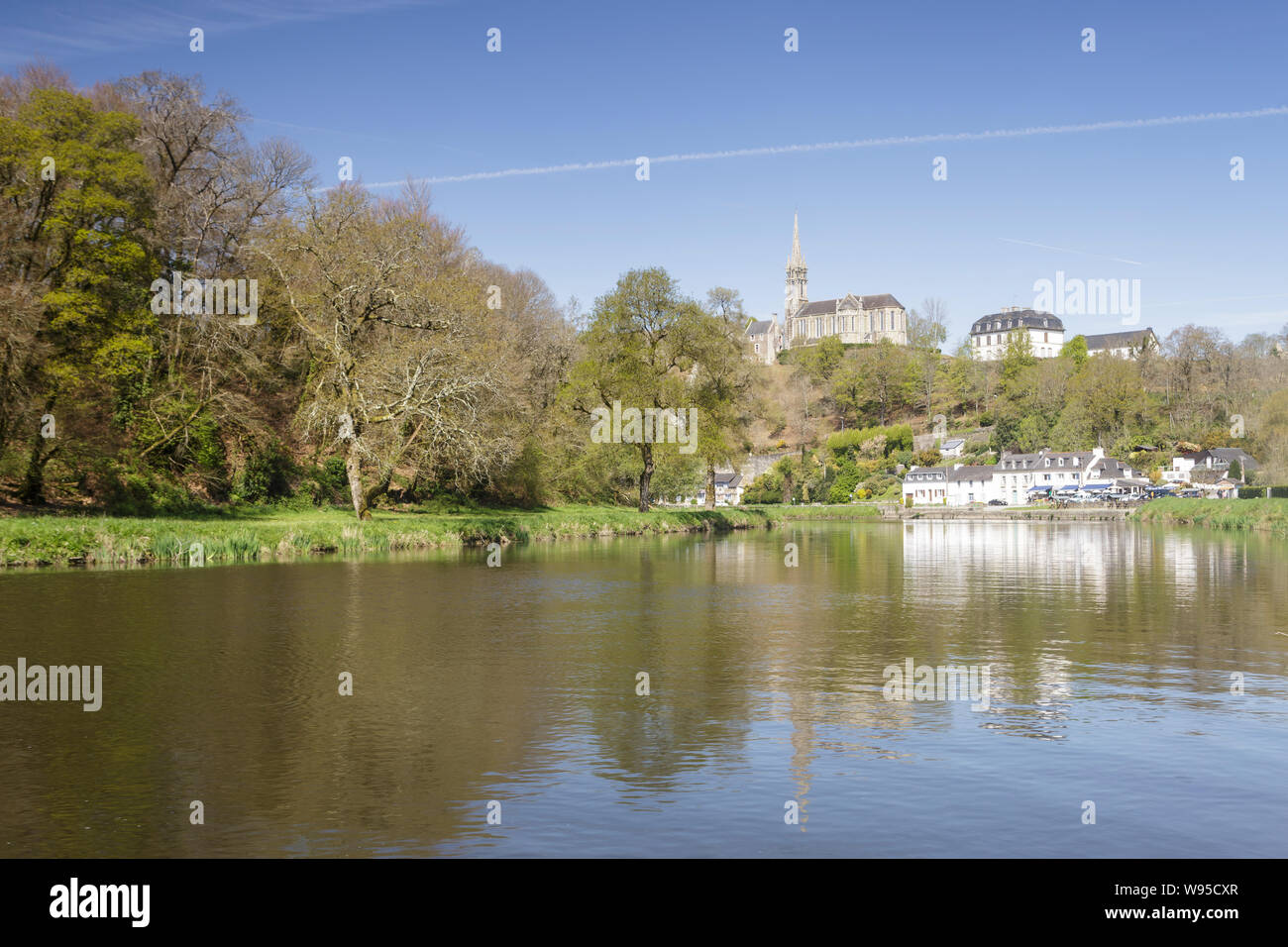Cateauneuf Du Faou
| Châteauneuf-du-Faou | |||
| — Comună — | |||
Châteauneuf-du-Faou | |||
| |||
Châteauneuf-du-Faou Poziția geografică | |||
| Coordonate: 48°11′N 3°49′W / 48.18°N 3.82°V48°11′N 3°49′W / 48.18°N 3.82°V | |||
|---|---|---|---|
| Țară | Franța | ||
| Regiunea | Normandia de Jos | ||
| Departament | Finistère | ||
| Arondisment | Châteaulin | ||
| Cod INSEE | 29027 | ||
| Reședință | Châteauneuf-du-Faou[*] | ||
| Guvernare | |||
| - Mayor of Châteauneuf-du-Faou[*] | Christian Ménard[*] (Uniunea pentru o Mișcare Populară) | ||
| Suprafață[3] | |||
| - Total | 42.58 km² | ||
| Populație (2009[1]) | |||
| - Total | 3682 locuitori | ||
| - Densitate | 86,47 loc./km² | ||
| Fus orar | UTC+1 | ||
| Cod poștal | 29520 | ||
| Cod INSEE | 29027 | ||
| Prezență online | |||
| site web oficial GeoNames | |||
| Poziția localității Châteauneuf-du-Faou | |||


Chateauneuf du Faou Tourism: Tripadvisor has 897 reviews of Chateauneuf du Faou Hotels, Attractions, and Restaurants making it your best Chateauneuf du Faou resource. The historical area of Chateauneuf-du-Faou awaits your stay. Enjoy the history and other features of Chateauneuf-du-Faou. This city has something for everyone. Whether you're planning a family holiday, a trip with friends or a romantic retreat, Vrbo has a great selection of holiday homes. Jan 10, 2021 - Browse and Book from the Best Vacation Rentals with Prices in Chateauneuf du Faou: View Tripadvisor's 416 photos and great deals on 15 vacation rentals, cabins and villas in Chateauneuf du Faou. Things to Do in Chateauneuf du Faou, France: See Tripadvisor's 30 traveler reviews and photos of Chateauneuf du Faou tourist attractions. Find what to do today, this weekend, or in January. We have reviews of the best places to see in Chateauneuf du Faou. Explore an array of Chateauneuf-du-Faou, FR vacation rentals, including houses, cottages & more bookable online. Choose from more than 82 properties, ideal house rentals for families, groups.
Châteauneuf-du-Faou este o comună în departamentul Finistère, Franța. În 2009 avea o populație de 3682 de locuitori.[1]
Note[modificare modificare sursă]

- ^ ab„Populația comunelor din Franța”. Toutes les villes. Accesat în .
- ^„Suprafața comunelor din Franța”. Toutes les villes. Accesat în .
- ^Répertoire géographique des communes, accesat în
Vezi și[modificare modificare sursă]
| ||||
Kastell-Nevez-er-Faou
Last modified: 2019-01-12 by ivan sache
Keywords: chateauneuf-du-faou
Links: FOTW homepage search disclaimer and copyright write us mirrors
Flag of Châteauneuf-du-Faou - Image by Arnaud Leroy, 29 June 2005
See also:
Presentation of Châteauneuf-du-Faou
The municipality of Châteauneuf-du-Faou (in Breton, Kastell-Nevez-er-Faou; 3,677 inhabitants in 2016; 4,258 ha; municipal website) is located in western central Brittany. The town is built on a small hill dominating a large meander of river Aulne, there canalized as the Canal de Nantes à Brest and crossed by the Old King's Bridge, built in 1638 under King Louis XIII.
Châteauneuf-du-Faou (Castellum novum, 12th century; Castrum novum, 1217; Castrum novum in fago, c. 1330 and 1368; Chasteauneuf du Faou, 1391) was the new fortress (castrum novum) built by the lords of Faou, a branch of the house of Léon. The Viscounts of Faou claimed to have emerged in the 6th century. The domain of Châteauneuf seceded from the ancient parish of Plouyé. Seized in 1186 by Guihomarch and Hervé de Léon, the fortress belonged to the Viscounts of Léon until confiscated by Duke of Brittany Jean VI in 1420. Ruined in 1440, it was subsequently suppressed to build the Our Ladu of the Gates chapel.
Cleaning Jobs In Chateauneuf Du Faou
The St. Julian and Our Lady church, rebuilt in 1878 by Jules Boyer except the bell tower, erected in 1737, was decorated in 1914-1919 by the painter Paul Sérusier (1863-1927), who spent 23 years in the town.
Sérusier went to Pont-Aven in 1888 where he met Paul Gauguin, who convinced him to make 'symbolist and synthetist' paintings. Under Gauguin's guidance, Sérusier painted a landscape called Talisman on the cover of a cigare box. Back to Paris, he showed the painting to his friends Maurice Denis, Pierre Bonnard, Édouard Vuillard, Paul Ranson and Ker Xavier Roussel; all of them founded the group of Nabis, named for a Hebrew word meaning 'a prophets'. Nicknamed by his friends 'the Nabi with the rutilant beard', Sérusier became with Maurice Denis the theoretician of the group. His later painting evolved towards a mystical, medieval archaism.
In 1438, a statue of the Blessed Virgin was found in the hollow trunk of an old tree. The miraculous finding was celebrated by the building of the Our Lady of the Gates chapel, a very popular place of pilgrimage in Brittany. A church-window of the chapel recalls the murder of a priest by the Royalist warlord Liscoet, who sacked the town in 1593 with his 400 men. The chapel was rebuilt in 1892-1893; the bell-tower was added in 1901-1902. The only remain of the former chapel is the Gothic porch built in the 15th century, maybe using stones from the ancient castle of Châteauneuf. One of the most famous pardons of Brittany is celebrated in the chapel at the end of August. The elders and invalids' pardon takes place on Friday; on Saturday, the statue of the Blessed Virgin is carried in procession by 50-year old men; on Sunday, following a solemn mass, the crowned statue of the Blessed Virgin is carried in procession by 50-year old women dressed in traditional costume.
There is an underground fountain dedicated to St. John the Baptist near the church. A statue of the saint holding a lamb under his left arm and trampling a beast, made in polychrome granit, can be seen near the fountain. St. John the Baptist was invoked to protect water from pollution and to cure eye diseases. Another fountain, dedicated to St. Gouesnou, can be seen in the Kermoal wood. Gouesnou, a Scottish bishop who fled his country occupied by the Saxons, spent 24 years in Brittany; he was killed on 25 October 675 with a hammer. His fountain was the place of a pardon celebrated on Ascension's Day; his cult, probably influenced by an older pagan cult, disappeared at the end of the 18th century but was still remembered at the beginning of the 20th century.
The Moustoir chapel (16th century), located 3 km of Châteauneuf, is famous for its baptistry and polychrome statues, and for the calvary (15th century) standing in front of the building. The enclosure of the chapel is planted with more than 6,000 flowers and shrubs. The chapel was dedicated to St. Ruellin, Bishop of Tréguier in the 6th century. Its spire was destroyed by lightning in the 19th century and the chapel was nearly ruined in the 1970s; a horses' pardon was celebrated there until the beginning of the 20th century. The chapel belonged to the Rosily-Meros family. Admiral Rosily, the son of the Commander of the Navy in Brest, took part to southern exploration and naval action against British vessels. Decorated by King Louis XVI, who erected him Rear Admiral, he refused twice the position of Minister of the Navy. Admiral Rosily reorganized the corps of the hydrographer engineers of the Navy.
[InfoBretagne]
Ivan Sache, 29 June 2005
Flag of Châteauneuf-du-Faou
The flag of Châteauneuf-du-Faou, as communicated by the municipal administration, is blue with a white castle with two towers and four black windows, and a white wave beneath it. The flag is a banner of the municipal arms, 'Azure a castle argent masoned and windows sable in base a fess wavy argent'.
Adopted in 1966, these arms superseded the previous ones, which featured a castle with had nine towers and were surmounted by a crown. The nine (French, 'neuf') towers made the arms spuriously canting, since neuf has to be read here as 'new'. The fess wavy represents river Aulne.
Arnaud Leroy & Ivan Sache, 29 June 2005

